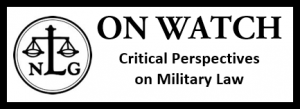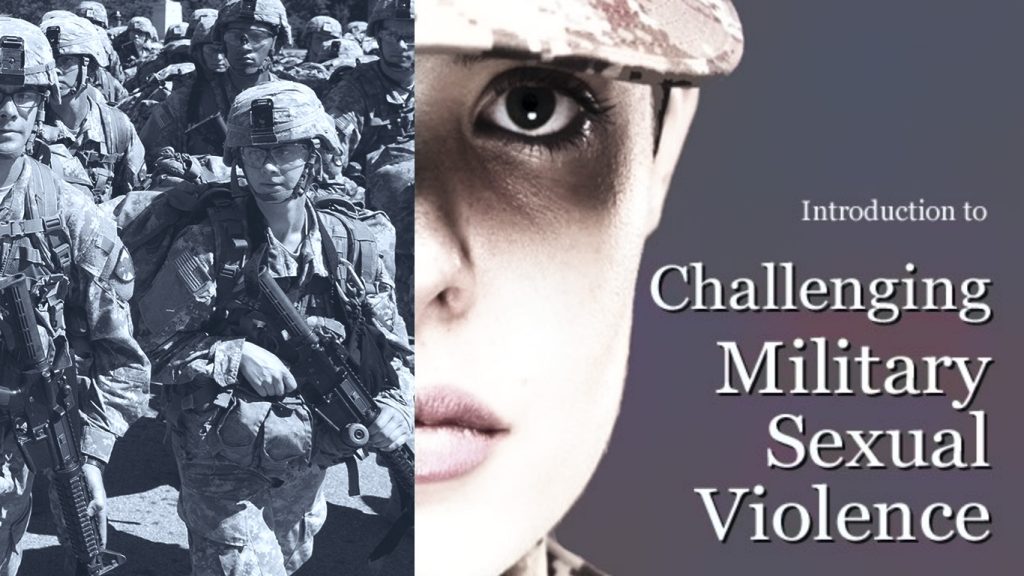By David Gesspass
Rev. Date: 2017 May
On November 27, 2009, the Department of Defense (DoD) issued Instruction 1325.06, to address the rights of members of the military to engage in free speech and dissent. The instruction canceled and replaced the prior DoD Directive 1325.6, which had been in effect since 1996; the instruction was in turn updated on February 22, 2012. It expresses the current policies and procedures to be followed by the armed forces regarding dissent and freedom of expression. Thus far, the Trump administration has not made any effort to change those policies and procedures which at least recognize that members of the Armed Forces have First Amendment protections. Since Mr. Trump seems to see the First Amendment as a hindrance to governance, one cannot say for how long these policies and procedures will be in effect. The MLTF will stay abreast of any changes and will revise this memo as updates become necessary.
The new instruction does not change very much from the prior versions. It does take into account advances in technology, addressing social media and the like, but the fundamental precepts remain the same. They are:
- The right of free expression is preserved to the maximum extent possible, meaning
- The right is limited by the needs of the military to maintain “good order and discipline”
- Commanders should not be “indifferent to conduct that, if allowed to proceed unchecked, would destroy the effectiveness of” their units
- The extent to which one’s freedom of expression is permitted relies on the discretion (one may say whim) of individual commanders
These presumed “principles” have not changed.
The new instruction lists the same punitive provisions of the UCMJ that can apply as did the directive, albeit with slightly different language, and warns that there may be other criminal provisions as well. It lists UCMJ Articles 82 (Solicitation), 89 (Disrespect toward a commissioned officer), 91 (Insubordinate conduct toward a warrant officer, noncommissioned officer or petty officer), 92 (Failure to obey an order or regulation), 101 (Improper use of a countersign), 104 (Aiding the enemy), and 117 (Provoking speeches or gestures).
The Instruction notes that there are criminal provisions in Chapter 18 of the U.S. Code that apply “to all persons.” The Code provisions remain the same, but the descriptive language changes somewhat. These changes in description are in sections 1381 (enticing desertion and harboring deserters), 2385 (advocating overthrow of the government), 2387 (activities affecting the armed forces generally) and 2388 (activities affecting the armed forces during war).
Taken together, these provisions can, within the military, arguably swallow the right of free expression entirely. In practice, they do not necessarily do so, but their very existence – and their inclusion in the Instruction – can intimidate people so they do not engage in protected conduct.
When planning or considering a particular protest or course of conduct, it is always helpful to consult with a lawyer to find out just what the potential consequences are. We emphasize that what one does is up to the individual, but no one should make decisions rashly or without understanding what risks are being taken. Further, the fact that individual commanders are expected to use their judgment as to what is, or is not, permitted can lead to widely disparate conclusions and policies in different commands.
Nevertheless, there are some fairly straightforward activities that are protected and others that are not.
▪ Periodicals. If a periodical is distributed through official outlets like post exchanges and military libraries, no individual issue can be banned. There may be an exception for “sexually explicit” material, but a process must be followed to determine what qualifies before something can be banned.
▪ Distribution of materials. Of more interest to activists (depending on what activity you are interested in) is that materials can be banned from distribution through unofficial channels if a commander decides they create a clear danger to the loyalty, discipline or morale of military personnel or materially interfere with the accomplishment of the military mission.
This can obviously encompass all manner of material questioning the role or mission of the U.S. military. There are, however, a couple of caveats. First, possession of such material cannot be prohibited absent a determination that it is going to be distributed, in which case it can be impounded. (Some commands have concluded that possession of more than one copy of any material implies distribution.) Second, the fact that the material is critical of government policies or officials is not, by itself, grounds for prohibition of distribution. Still, the line between mere criticism and creating a clear danger is, at best, blurry. Indeed, it may be that how effective the criticism is will determine when it becomes a clear danger. One can claim incessantly that US military adventures in the Middle East are counterproductive, violative of international law and serve only to enrich arms merchants but, so long as everyone does their job and the adventures continue, commanders may not care. But, if personnel start questioning what they are risking their lives for and whether it is worth it, that same material could be deemed dangerous.
▪ Off-post gathering places. During the Vietnam War, coffeehouses sprang up outside military bases in the US and overseas that encouraged resistance to the war and provided legal assistance to deserters and resisters. While they were run by civilians, they were engendered by resistance within military ranks. Thus, while they encouraged such resistance and hoped to expand it, they did not initiate it.
The rulers of the country do not want such gathering places to be replicated. Thus, the instruction authorizes commanders to place “off-post gathering places” off limits when they engage in activities such as “counseling, encouraging, or inciting Service members to refuse to perform duty or to desert; pose a significant adverse effect on Service members’ health, morale, or welfare; or otherwise present a clear danger to the loyalty, discipline, or morale of a member or military unit.” Significantly, these are examples of the kinds of activities that could result in such sites being placed off limits, but the list is not exhaustive. That is to say, even if no one engages in these precise activities – and it is hard to imagine what else there might be – there is no guarantee you won’t be placed off limits. For example, one could well argue that warning people of the potential for sexual violence and the lack of effective remedies may have “a significant adverse effect” on the morale of one or more members.
▪ Unions are still prohibited and commanders are not permitted to engage in collective bargaining. That may be one reason why the military can violate its contracts with its members with impunity (see Stop Loss) while members can be prosecuted criminally for missing work or quitting their jobs.
▪ Writing. The instruction quite reasonably prohibits members from writing for publication, including electronic publication, while on duty or while using government equipment. It also quite reasonably permits it for anyone off duty and using their own equipment.
Once again, however, there is a vague caveat that, “if such a publication contains language the utterance of which is punishable under Federal law or otherwise violates this Instruction or other DoD issuances,” a member may be disciplined. So, to be sure you are in compliance, all you need is an encyclopedic knowledge of federal criminal law and DoD regulations. No need to worry.
▪ Demonstrations on post are generally prohibited. However, activities (presumably including demonstrations) are, by the terms of the instruction only prohibited if they interfere with the military mission or present a clear danger to loyalty, discipline or morale. While that leaves a possible defense to a claim that a particular demonstration was lawful, it seems unlikely any commander or judge would buy it.
▪ Demonstrations off-post. While the instruction talks about what military personnel are prohibited from doing if they want to participate in demonstrations off-post, it is perhaps better to put it in positive terms. That is, personnel are free to participate in demonstrations and other such activities off post with certain prohibitions. The easy ones are that you cannot be in uniform, on duty, or in a foreign country, nor can you say or do things that imply you are representing the military.
There are two other prohibitions that are pretty vague and uncertain. If the “activities constitute a breach of law and order” or if “violence is likely to result,” military personnel cannot participate. Of course, the breach of law and order, if there is one, will likely happen during the demonstration and, if past is prologue, such a breach will only be engaged in by a small number of participants or, quite possibly, law enforcement. And how one can know beforehand that violence can result is a mystery as few, if any, demonstrations announce a plan to engage in violence beforehand. Moreover, law enforcement often predicts violence as a means of reducing the size of demonstrations without any real justification.
▪ Advocacy and association. Military personnel are prohibited from actively advocating supremacist, extremist or criminal gang doctrine, ideology or causes. They are specifically not to advocate anything that attempts to create discrimination on the basis of race, creed, color, sex, religion, ethnicity or national origin (evidently, the president is exempt). Notably, sexual orientation and gender identity are not included, though one could argue they are subsumed by sex. Further, ironically for the military, personnel may not advocate the use of force or violence and may not seek to deprive others of civil rights. Interestingly, having gang tattoos is defined as active participation in gang activities.
Commanders are admonished to look for signs of any violations covered by the instruction and to intervene early if they see such signs, primarily through counseling. The instruction states that “[w]hile mere membership or possession of literature [associated with criminal gangs or extremist organizations] normally is not prohibited, it may merit further investigation and possibly counseling to emphasize the importance of adherence to the Department’s values and to ensure that the Service member understands what activities are prohibited.” On the one hand, early intervention can certainly result in addressing problems before they get out of control. On the other hand, the admonition may well prompt commanders to act precipitously, warning people engaged in protected activity. That can lead to self-censorship, as people fear their protected First Amendment activities will get them into trouble.
Conclusion
The First Amendment necessarily admits of only narrow exceptions. Members of the military are somewhat more constrained than are private citizens, but their freedoms of speech and association are also protected, and constitutional rights are of no value if they are not exercised. Particularly because commanders are given broad discretion and the instruction itself draws few bright lines, even members of the military should not be afraid to test the limits of what is permitted and what is not. That does not mean that people should violate the specific limits that are placed on those rights by the instruction. Rather, it means that any action taken should be done consciously, with the risks understood and the arguments in favor of the action well thought out.
The MLTF is committed to defending the First Amendment rights of military personnel who choose to resist US imperialism and its current policy of perpetual war. We will do all we can to provide the best possible guidance as to the possible consequences of any planned action or activity and to defend anyone who faces adverse consequences.
David Gespass is an attorney in private practice in Birmingham, Alabama. He is a former president of the National Lawyers Guild, and currently a member of the Military Law Task Force steering committee.



